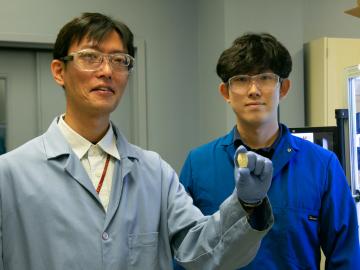
Filter News
Area of Research
- (-) Materials (52)
- Advanced Manufacturing (4)
- Biological Systems (2)
- Biology and Environment (73)
- Computational Biology (1)
- Computational Engineering (2)
- Computer Science (2)
- Energy Science (67)
- Fusion and Fission (4)
- Fusion Energy (1)
- Isotope Development and Production (1)
- Isotopes (27)
- Materials for Computing (10)
- Mathematics (1)
- National Security (24)
- Neutron Science (18)
- Nuclear Science and Technology (10)
- Quantum information Science (3)
- Supercomputing (84)
News Topics
- (-) Bioenergy (11)
- (-) Clean Water (3)
- (-) Composites (9)
- (-) Cybersecurity (4)
- (-) Exascale Computing (2)
- (-) Isotopes (13)
- (-) Polymers (17)
- (-) Space Exploration (2)
- (-) Summit (2)
- 3-D Printing/Advanced Manufacturing (23)
- Advanced Reactors (4)
- Artificial Intelligence (9)
- Big Data (2)
- Biology (4)
- Biomedical (7)
- Buildings (5)
- Chemical Sciences (32)
- Computer Science (17)
- Coronavirus (4)
- Critical Materials (13)
- Energy Storage (34)
- Environment (15)
- Frontier (3)
- Fusion (7)
- Grid (5)
- High-Performance Computing (4)
- Irradiation (1)
- ITER (1)
- Machine Learning (5)
- Materials (73)
- Materials Science (78)
- Mathematics (1)
- Microscopy (27)
- Molten Salt (3)
- Nanotechnology (39)
- National Security (3)
- Neutron Science (33)
- Nuclear Energy (16)
- Partnerships (11)
- Physics (28)
- Quantum Computing (3)
- Quantum Science (11)
- Security (2)
- Simulation (1)
- Transportation (14)
Media Contacts

The presence of minerals called ash in plants makes little difference to the fitness of new naturally derived compound materials designed for additive manufacturing, an Oak Ridge National Laboratory-led team found.

Eight ORNL scientists are among the world’s most highly cited researchers, according to a bibliometric analysis conducted by the scientific publication analytics firm Clarivate.

Oak Ridge National Laboratory scientists designed a recyclable polymer for carbon-fiber composites to enable circular manufacturing of parts that boost energy efficiency in automotive, wind power and aerospace applications.

Laboratory Director Thomas Zacharia presented five Director’s Awards during Saturday night's annual Awards Night event hosted by UT-Battelle, which manages ORNL for the Department of Energy.

Researchers at ORNL explored radium’s chemistry to advance cancer treatments using ionizing radiation.

ORNL has been selected to lead an Energy Frontier Research Center, or EFRC, focused on polymer electrolytes for next-generation energy storage devices such as fuel cells and solid-state electric vehicle batteries.

Researchers at ORNL are tackling a global water challenge with a unique material designed to target not one, but two toxic, heavy metal pollutants for simultaneous removal.

ORNL researchers have developed an upcycling approach that adds value to discarded plastics for reuse in additive manufacturing, or 3D printing.

Two decades in the making, a new flagship facility for nuclear physics opened on May 2, and scientists from the Department of Energy’s Oak Ridge National Laboratory have a hand in 10 of its first 34 experiments.

A world-leading researcher in solid electrolytes and sophisticated electron microscopy methods received Oak Ridge National Laboratory’s top science honor today for her work in developing new materials for batteries. The announcement was made during a livestreamed Director’s Awards event hosted by ORNL Director Thomas Zacharia.


